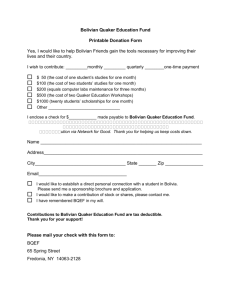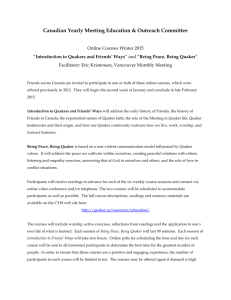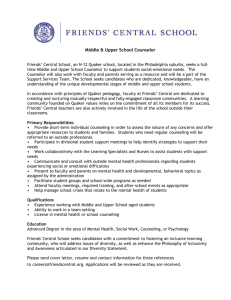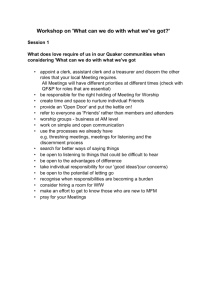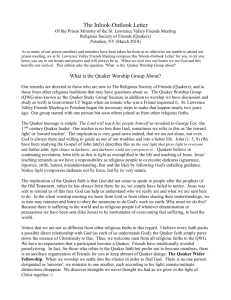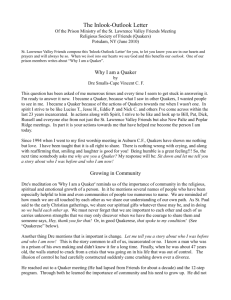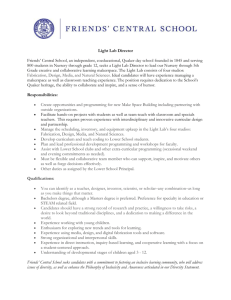Quaker_History
advertisement
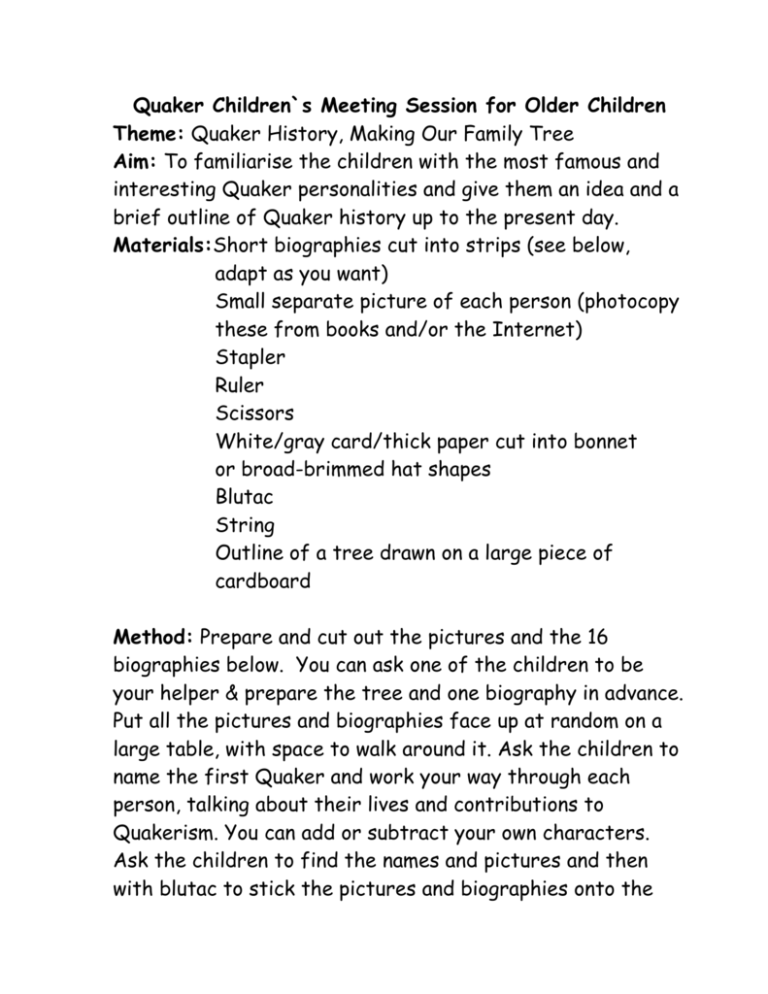
Quaker Children`s Meeting Session for Older Children Theme: Quaker History, Making Our Family Tree Aim: To familiarise the children with the most famous and interesting Quaker personalities and give them an idea and a brief outline of Quaker history up to the present day. Materials:Short biographies cut into strips (see below, adapt as you want) Small separate picture of each person (photocopy these from books and/or the Internet) Stapler Ruler Scissors White/gray card/thick paper cut into bonnet or broad-brimmed hat shapes Blutac String Outline of a tree drawn on a large piece of cardboard Method: Prepare and cut out the pictures and the 16 biographies below. You can ask one of the children to be your helper & prepare the tree and one biography in advance. Put all the pictures and biographies face up at random on a large table, with space to walk around it. Ask the children to name the first Quaker and work your way through each person, talking about their lives and contributions to Quakerism. You can add or subtract your own characters. Ask the children to find the names and pictures and then with blutac to stick the pictures and biographies onto the drawn tree. Let them choose whether or not to put the oldest at the top, bottom or in the centre of the tree. Allow time to assemble the bonnets and/or hats to be worn into meeting for worship. Ask the children to describe what they have been doing to the adults in notices after MFW. Our Quaker Family Tree (enlarge font heading) George Fox (born 1624 died 1691) Founder of the Religious Society of Friends (Quakers). Born in Leicestershire, England. His father, Christopher, was a weaver and he had 6 brothers and sisters. He thought “If God can speak to me, a weaver’s son, he can speak to any man, woman or child who wants to listen.” Margaret Fell (born 1614 died 1702) Mother of Quakerism, her home Swarthmore Hall, became the first Quaker HQ. She was married to judge Thomas Fell who never became a Quaker but he supported and protected them. 11 years after he died she married George Fox. William Penn (born 1644 died 1718) married Gulielma Penn (born 1624 died 1693) Founder of the Holy Experiment Quaker State of Pennsylvania in the USA. The capital city is Philadelphia meaning brotherly love. Asked by Charles 11 of England to set up a new colony based on freedom and peace. 70 Quakers arrived in 1682 in a small ship “Welcome” from England (30 had died from smallpox during the crossing). He was very fair to the American Indians, he bought their land instead of taking it from them without payment. They gave him a special belt for friendship. He always kept his hat on even in front of the King. He always wore a sword until he asked George Fox what to do about his sword and Fox replied ‘Wear it as long as you can.” James Naylor (born 1618 died 1660) Very good speaker and misunderstood preacher. Wrote Quaker leaflets. Imprisoned and had his tongue burned through with a hot iron and “B” for blasphemer branded on his forehead for riding into Bristol, England on a donkey shouting “Holy, holy, holy” pretending to be Jesus. Mary Dyer (born 1618 hanged 1660) Brave young American Quaker hanged in Boston in 1660 for her Quaker beliefs. Mary Fisher (born 1623 died 1698) One of Fox’s first followers who as a very brave young woman Mary tried to encourage the Muslim Sultan of Turkey to become a Quaker. She was imprisoned in Boston and her books were burnt. John Woolman (born 1720 died 1772) American Quietist Quaker helped to abolish slavery and was a friend of the American Indians. He was an animal rights activist and early environmentalist. Edward Hicks (born 1780 died 1849) American Quaker artist who painted 100 versions of “Peaceable Kingdom” showing wild and tame animals together and Quakers talking to American Indians. John Dalton (born 1766 died 1844) English Quaker chemist who developed and discovered the Atomic Theory which led to the splitting of the atom and atomic energy. His father was a weaver too like George Fox's. Elizabeth Fry (born 1780 died 1845) English Quaker who was famous for her work with women in Newgate prison in London and she set up the first prison school. She visited every convict ship taking women to Botany Bay, Australia she and gave them a bag of useful things to make a patchwork quilt on their ship journey to Australia to stop boredom and have something to sell when they arrived. John Greenleaf Whittier (born 1807 died 1892) American Quaker poet and hymn writer of:“Dear Lord and Father of mankind Forgive our foolish ways.... He also worked very hard to stop slavery. Lucretia Mott (born 1793 died 1880) A gentle American Quaker who helped to end slavery and win equality for women. George Cadbury (born 1839 died 1922) English Quaker chocolate maker of Cadbury’s and founder of Bournville village in Birmingham. He and his wife donated their lovely house to be used as the Woodbrooke Quaker Study Centre. Richard Hudson (born 1841 died 1903) A successful New Zealand businessman, who with the Cadbury brothers George and Edward set up the New Zealand company in Dunedin. They called it Cadbury Fry Hudson. You can visit the factory and have a tour. Bertha Jackson (born 1865 died 1936) Ann Fletcher Jackson (born 1833 died 1903) Early Quaker settlers in New Zealand who came with their large family from England in a small ship the “James Wishart”. Ann was Bertha's mother and their family settled in Auckland and cured many Maori and Pakeha of illnesses with the homeopathic medicines they brought from England. Ann traveled around NZ making a very useful list of all the Quakers who lived there and helping to set up meetings for them. Sydney Parkinson (born He was the first Quaker to visit New Zealand. He was a natural historian and artist who traveled with the famous explorer James Cook in the 1770's. William Trusted (born The first English Quaker who settled in New Zealand from 1836. He lived in Hokianga near Auckland. Maori iwi of the area are still very proud to be his descendants. His partner Pikare and he had only one child, Betsy who later also married a Maori and they had 17 children. Instructions for making the Quaker bonnets/hats:(See illustrations in the book “Lucretia Mott Each Little Act of Kindness” p48-50 in Quaker Library 126.0.7). Quaker Bonnets:Cut out pieces of strong white or gray paper or card 18” x 14”. Cut 2 slits 6” apart and 6 ½” long. Fold over the tops to form the bonnet and staple in place. Staple 2 pieces of string or plain ribbon to tie the bonnet onto your head. Quaker Broad-brimmed Hats:Cut out fronts of appropriate size for your children from black cardboard . Cut out strip of cardboard to fit each child's head size. Staple in a circle and then staple top the back of the hat front. Alison Wallace wallace_alison@hotmail.com September 2006
